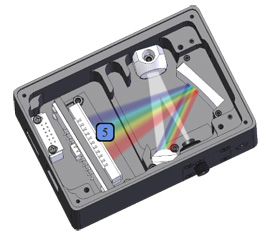Part 5: Spectral Resolution
Introduction
 One of the most important characteristics of a spectrometer is the spectral (or optical) resolution. The spectral resolution of a system determines the maximum number of spectral peaks that the spectrometer can resolve. For example, if a spectrometer with a wavelength range of 200nm had a spectral resolution of 1nm, the system would be capable of resolving a maximum of 200 individual wavelengths (peaks) across a spectrum.
One of the most important characteristics of a spectrometer is the spectral (or optical) resolution. The spectral resolution of a system determines the maximum number of spectral peaks that the spectrometer can resolve. For example, if a spectrometer with a wavelength range of 200nm had a spectral resolution of 1nm, the system would be capable of resolving a maximum of 200 individual wavelengths (peaks) across a spectrum.
In dispersive array spectrometers, there are 3 main factors that determine the spectral resolution of a spectrometer: the slit, the diffraction grating, and the detector. The slit determines the minimum image size that the optical bench can form in the detector plane. The diffraction grating determines the total wavelength range of the spectrometer. The detector determines the maximum number and size of discreet points in which the spectrum can be digitized.
Measuring Spectral Resolution
It is important to understand that the observed signal (So) is not solely dependent on the spectral resolution of the spectrometer (R) but it is also dependent on the linewidth of the signal (Sr). As a result, the observed resolution is the convolution of the two sources,
![]()
Equation 5-1
When the signal linewidth is significantly greater than the spectral resolution, the effect can be ignored and one can assume that the measured resolution is the same as the signal resolution. Conversely, when the signal linewidth is significantly narrower than the spectrometer resolution, the observed spectrum will be limited solely by the spectrometer resolution.
For most applications it is safe to assume that you are working in one of these limiting cases, but for certain applications such as high resolution Raman spectroscopy, this convolution cannot be ignored. For example, if a spectrometer has a spectral resolution of ~3cm-1 and uses a laser with a linewidth of ~4cm-1, the observed signal will have a linewidth of ~5cm-1 since the spectral resolutions are so close to each other (assuming a Gaussian distribution).
For this reason, when attempting to measure the spectral resolution of a spectrometer it is important to assure that the measured signal is significantly narrow to assure that the measurement is resolution limited. This is typically accomplished by using a low pressure emission lamp, such as an Hg vapor or Ar, since the linewidth of such sources is typically much narrower than the spectral resolution of a dispersive array spectrometer. If narrower resolution is required, a single mode laser can be used.
After the data is collected from the low pressure lamp, the spectral resolution is measured at the full width half maximum (FWHM) of the peak of interest.
Calculating Spectral Resolution
When calculating the spectral resolution (δλ) of a spectrometer, there are four values you will need to know: the slit width (Ws), the spectral range of the spectrometer (Δλ), the pixel width (Wp), and the number of pixels in the detector (n). It is also important to remember that spectral resolution is defined as the FWHM. One very common mistake when calculating spectral resolution is to overlook the fact that in order to determine the FWHM of a peak, a minimum of three pixels is required, therefore the spectral resolution (assuming the Ws = Wp) is equal to three times the pixel resolution (Δλ/n). This relationship can be expanded on to create a value known as resolution factor (RF), which is determined by the relationship between the slit width and the pixel width. As would be expected, when Ws ≈ Wp the resolution factor is 3. When Ws ≈ 2Wp the resolution factor drops to 2.5, and continues to drop until Ws > 4Wp when the resolution factor levels out to 1.5.
All of this information can be summarized by the following equation,

Equation 5-2
For example, if a spectrometer uses a 25µm slit, a 14µm 2048 pixel detector and a wavelength range from 350nm – 1050nm, the calculated resolution will be 1.53nm.
Browse our extensive line of spectrometers.
Submit your questions using the “Request Quote or Info” button above, or call us at (302) 368-7824.







